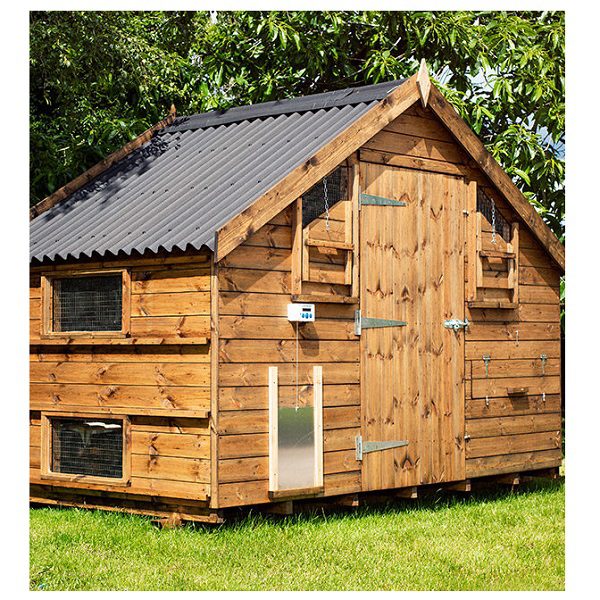


The “Extreme” model is for anyone who keeps chickens in an extreme climate, such as Arctic Alaska or the deserts of Australia. With the latter option you can, for instance, set the door to open at a specific time in the morning but close at dusk, whatever time dusk might occur. So instead of adjusting opening and closing times by moving the sensor - to get more sun exposure so the door opens a little earlier and closes a little later, or more shade so the door opens a little later and closes a little earlier, the ChickenGuard has both a sensor delay feature and the ability to combine the sensor and timer to complement one another. ChickenGuard makes this a non issue, because the light sensor is part of the control unit itself. But if you have dairy goats, like I do, be prepared to replace chewed-up sensor cables. Our other three door openers have a cable with the light sensor at the end, which allows flexibility for adjusting the sensor’s position relative to the sun. Turning on a floodlight opens the chicken door, so I have to remember to turn off the light after bed check is done.Ī really nice feature of the ChickenGuard is that the light sensor is integrated into the control unit. My yards have floodlights I occasionally use to check for young chickens that might have missed closing time. A security lamp or back porch light, or even a light shining through the coop window at night, can confuse the sensor into thinking it’s daytime. The sensor must receive light during the day - ideally on a west facing wall (toward the setting sun) - and be in the dark at night. The “Premium” model has both a timer and a daylight sensor that can be set to automatically open the coop door at dawn and close it at dusk. Ducks are especially notorious for hiding their eggs unless they are confined during their morning laying hours.

On the other hand, being able to set the timer for a late morning opening is great if you have predators lurking at dawn waiting for the door to open, or you want to keep your birds in until they finish laying. Using a timed evening closing means you have to constantly change the timer as daylight hours lengthen or shorten throughout the year. It has only a timer that lets you program what times you want the door to open and close. The door is a generous 12 inches wide by 16 inches high, enough to accommodate most chickens, guineas, ducks, and the lighter breeds of turkeys and geese.Īnd now for the differences between the three models. All three come with or without an aluminum door and a pair of sturdy oak runners. Then it’s goodbye internal batteries!All three ChickenGuard models operate at temperatures from 110✯ down to -10✯ and are covered by a three year warranty. All you need is an Abosi universal wall charger and a type A male-to-male USB cable. Anyway, the high tech ChickenGuard is readily adaptable to plug-in power via a USB port at the bottom of the unit. The most difficult part of operating a door opener with internal batteries is changing the batteries, which involves removing screws that hold the control unit cover and wiggling out the battery compartment. Personally, I prefer plug-in door openers. If I could go back and do it over, they’d all be like that.) (Okay, in case you are a math whiz wondering why I have three chicken coops and four door openers: One of my coops has two doors providing entry into two different fenced yards. The doors normally operate on main power, but if the power goes out they keep going on a fully charged battery. My other three chicken doors use an external 12-volt battery with a 120-volt adapter.

A Brand X door opener I once had simply quit when the batteries ran down - not good if the flock gets locked in all day or, worse, the door stays open all night! A set of batteries should last at least six months, but a good management plan is to put in fresh ones during the twice-annual time change. When the batteries run low, the door-closed indicator light stays on continuously. When the door closes, a red indicator light blinks to let you know, from as far away as 100 yards, that your chickens are safely inside.įour AA batteries are included. They all additionally have a timer that lets you specify when you want the door to automatically open in the morning and close at night.
Chicken guard door full#
They may be operated manually, for when you want full control over opening and closing the door. All three have certain features in common. The control unit is available in three different models. Its spool, enclosed in a weather resistant plastic box, operates electronically and is programmed via three buttons and a generous LCD display. ChickenGuard is arguably the most sophisticated of the string-lift doors.


 0 kommentar(er)
0 kommentar(er)
